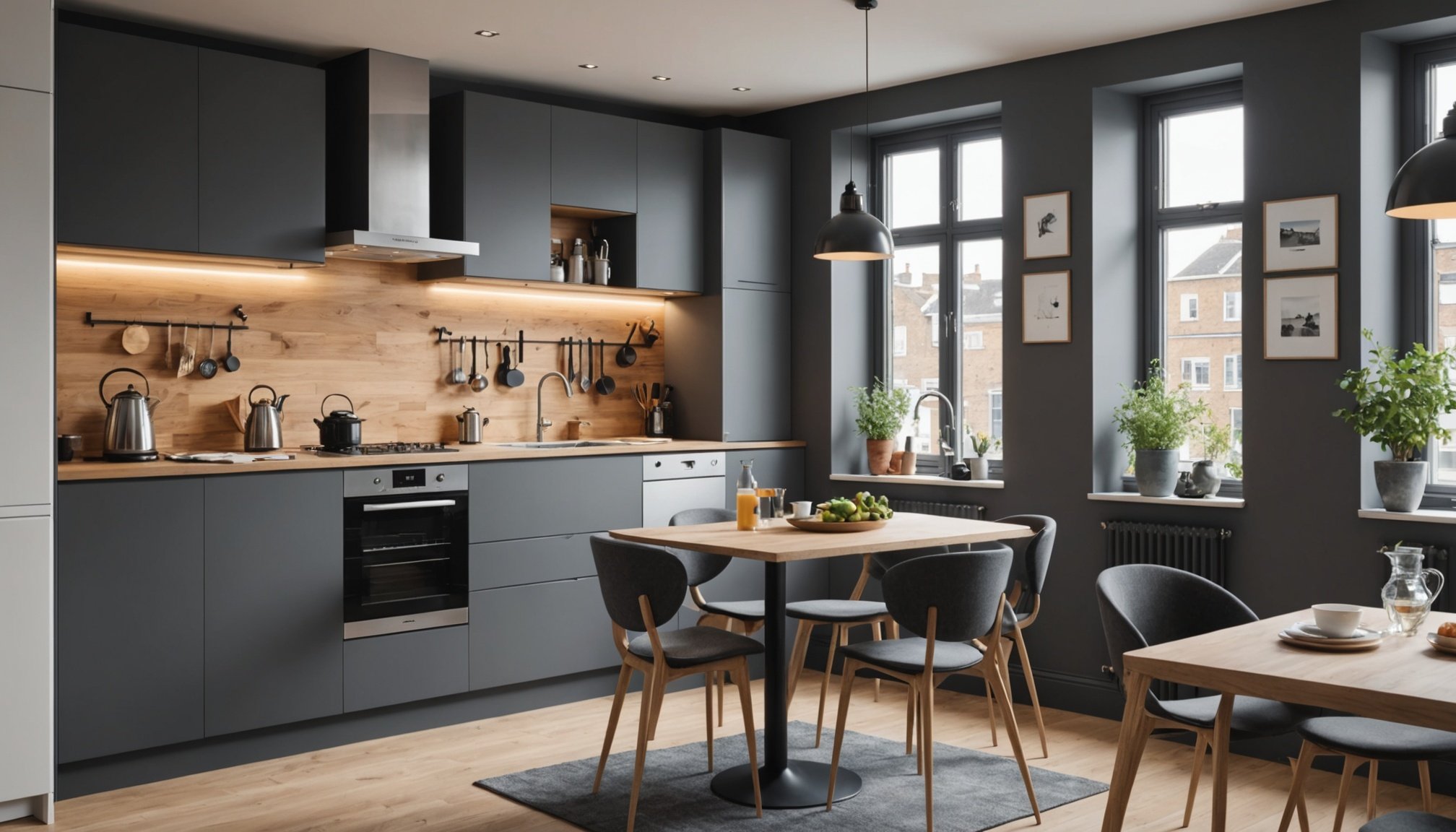Understanding the Challenges of Small Kitchens
Within studio flats and compact living spaces, small kitchens in the UK often present unique design challenges. These kitchens typically face limitations such as restricted square footage, insufficient storage, and constrained workspace. Navigating these hurdles is essential for maximizing the functionality of such confined areas.
The foremost challenge is efficiently using every inch of available space. In small kitchens, the design must cater to the dual needs of efficiency and aesthetics. Without careful planning, small kitchens can feel cramped and unwieldy. Modern residents desire a harmonious blend of utility and style, where functionality doesn’t sacrifice visual appeal.
In the same genre : Revitalize your city landscape: the ultimate guide to creating a rain garden for effective stormwater management in the uk
Maximizing functionality involves strategic design choices that enhance both ease of use and overall appearance. Residents often prefer solutions that provide enough storage and simplify cooking tasks, ensuring everyday activities remain convenient. Clever integrations, such as pull-out tables or slimline appliances, are increasingly popular due to their space-conserving qualities.
Ultimately, understanding these limitations equips homeowners and designers to craft more livable spaces that align with personal preferences while addressing practical needs, enhancing both day-to-day life and aesthetic satisfaction for the small kitchen user.
Topic to read : Revamp your uk apartment: create a stylish and functional home office retreat
Innovative Space-Saving Solutions
In the realm of space-saving solutions, one innovative approach is using compact furniture. Multi-functional designs, like foldable tables and chairs, create room for other essential activities. When you’re done dining, simply tuck them away!
When it comes to storage, consider under-counter cabinets. These sneaky spaces are perfect for hiding away pots and pans, maintaining a tidy kitchen.
And don’t forget the creative use of vertical space. Think additional shelves above countertops or magnetic strips on walls for utensils. By building upwards, you’re freeing valuable surface area below.
Explore the magic of multi-functional furniture concepts. Specifically designed to serve multiple purposes, this kind of furniture doesn’t just save space; it also enhances the room’s versatility. For example, a sleek, extendable dining table can double as a kitchen prep counter.
With these thoughtful design choices, studio flats and compact kitchens in the UK can embrace both style and functionality. Not only do they maximise limited spaces, but they also offer solutions that meet modern residents’ needs. Transform your kitchen into a harmonious blend of utility and elegance.
Optimal Layouts for Efficiency
The layout of small kitchens greatly impacts efficiency. For UK studio flats, considering optimal kitchen layouts is crucial. The kitchen work triangle, a concept focusing on the distance between the stove, sink, and refrigerator, is key to streamlined design. This arrangement minimizes unnecessary movement and enhances workflow, allowing for a more cohesive culinary experience. It enables efficient design, serving both functionality and space constraints.
Maximal Use of Triangle Layout
The work triangle’s benefits are immense, especially in confined spaces. Ensuring each area is easily accessible reduces clutter and enhances workflow. This layout is not just about convenience; it’s about transforming small kitchens into highly efficient design spaces that support daily activities effortlessly.
Open Shelving vs. Closed Cabinets
When determining storage solutions, choosing between open shelving and closed cabinets impacts both accessibility and aesthetics. Open shelving offers visual appeal by displaying items, fostering a spacious feel. However, closed cabinets provide hidden storage, essential for maintaining neatness. Balancing these options caters to diverse needs and preferences.
Customizable Design Options
Tailoring layouts to the specific dimensions of UK studio flats often involves integrating built-in appliances. These solutions maximize space while offering sleek finishes. Customizable designs not only accommodate unique spatial limits but also reflect personal style, ensuring a functional yet efficient design.
Color Schemes and Aesthetics
Choosing the right color schemes can transform the perceived size of small kitchens, particularly in compact UK studio flats. Light hues like whites, creams, and pastels can make spaces feel larger and airier, adding an illusion of expanded space. These shades, paired with reflective surfaces, optimize light distribution, enhancing the aesthetic feel.
In terms of design trends, the contemporary kitchen scene in the UK gravitates towards minimalism. Sleek lines and cohesive color palettes help cultivate a streamlined look that complements small kitchens. This environment not only appears tidy but can also highlight focal points, like unique tiles or countertops, adding depth and interest.
Balancing aesthetics with utility is crucial. While bold colors might make a style statement, they can dominate a space and make it feel cramped. Instead, consider accent walls or vibrant backsplash tiles to introduce intrigue without overwhelming the room. By blending enticing design with practical utility, kitchens maintain an inviting atmosphere without sacrificing functionality. In sum, clever use of colors elevates the appeal and functionality of small kitchen layouts, aligning them with modern trends.
Budget-Friendly Design Ideas
Creating an efficient and aesthetically pleasing kitchen in a budget-friendly way requires smart decisions. Opt for cost-effective solutions like peel-and-stick backsplashes or butcher block countertops, which mimic pricier options without breaking the bank. These alternatives provide visual appeal and durability suitable for daily use.
DIY projects are another avenue for enhancing kitchen efficiency on a budget. For instance, refurbishing existing cabinets with new paint and handles can impart a fresh look without substantial expense. Additionally, constructing open shelves using reclaimed wood adds both functionality and character to the kitchen space.
Several affordable transformations showcase how clever ideas can revamp a kitchen. Consider before-and-after case studies where minor updates made significant impacts. One example might feature replacing cabinet doors with frosted glass to introduce modernity and openness. These subtle changes breathe new life into small kitchens without considerable financial outlay.
Moreover, incorporating budget-friendly lighting, such as LED strips under cabinets, can accentuate the kitchen’s features and enlarge the perceived space. These practical solutions illustrate that effective and appealing kitchen improvements are achievable without extensive budgets, making the process accessible for those in studio flats.
Case Studies and Real-Life Examples
Dive into the world of design case studies to see how UK studio flats have transformed their small kitchens with ingenuity. These examples provide not only inspiration but also practical insight into overcoming space constraints. One standout transformation shows how clever before and after designs can maximise potential.
A compact kitchen from London, for instance, ingeniously utilised under-counter cabinets and multi-functional furniture. Before, it felt cramped and cluttered. After the transformation, it boasts a cohesive layout with a seamless blend of open shelving and closed cabinets, prioritizing efficient storage without sacrificing aesthetics.
Another example from Manchester reveals the significant impact of color schemes in small spaces. Initially dominated by dull colours, a switch to lighter pastels and reflective surfaces brought an airy, more expansive feel, illustrating how strategic design choices can alter perceptions of space.
These practical examples not only highlight diverse solutions but also cater to varying user needs and preferences. Key takeaways include the importance of personalized designs and keeping efficiency at the forefront. These case studies can inspire small kitchen owners to explore innovative methods tailored to their space.





